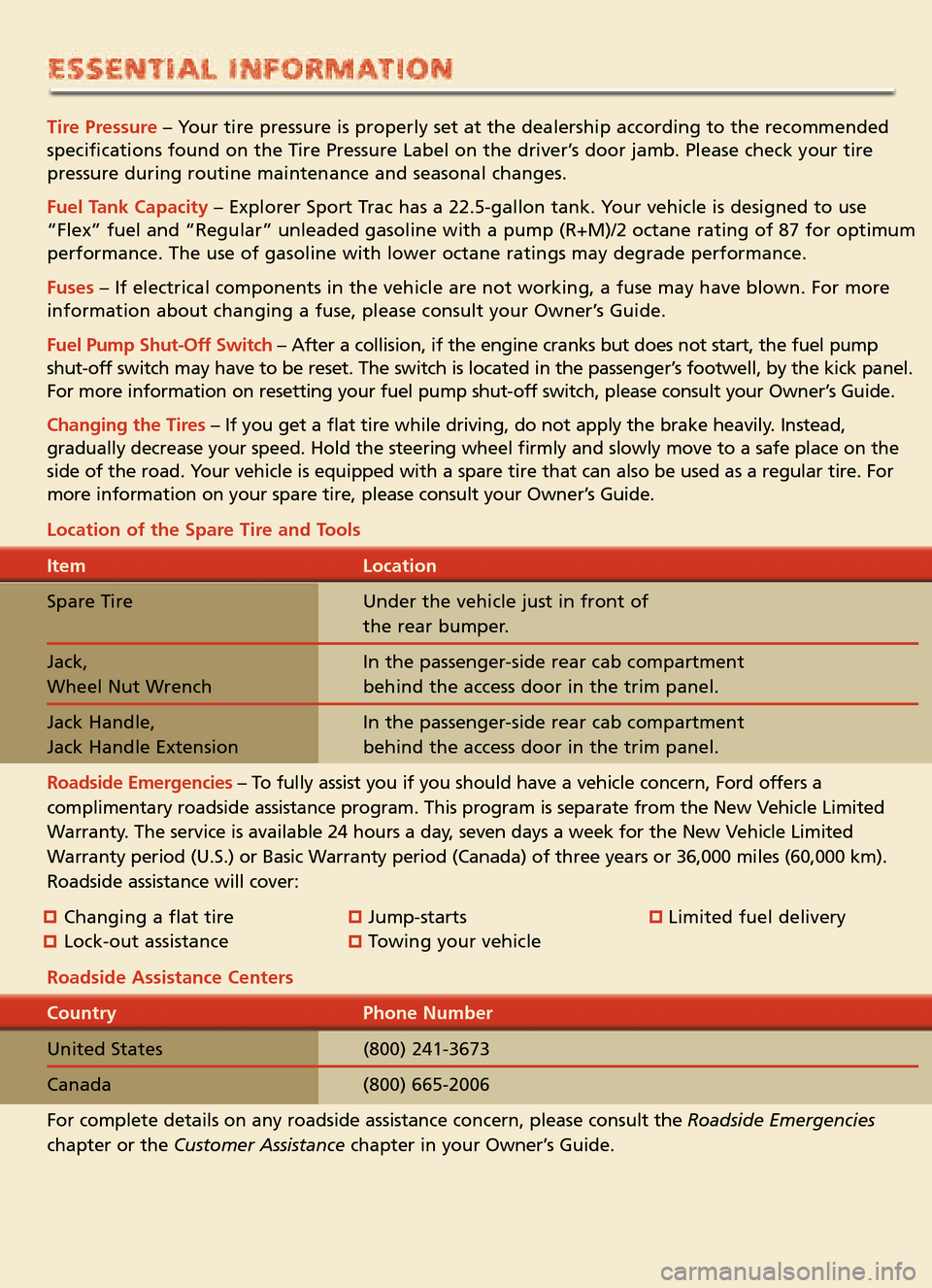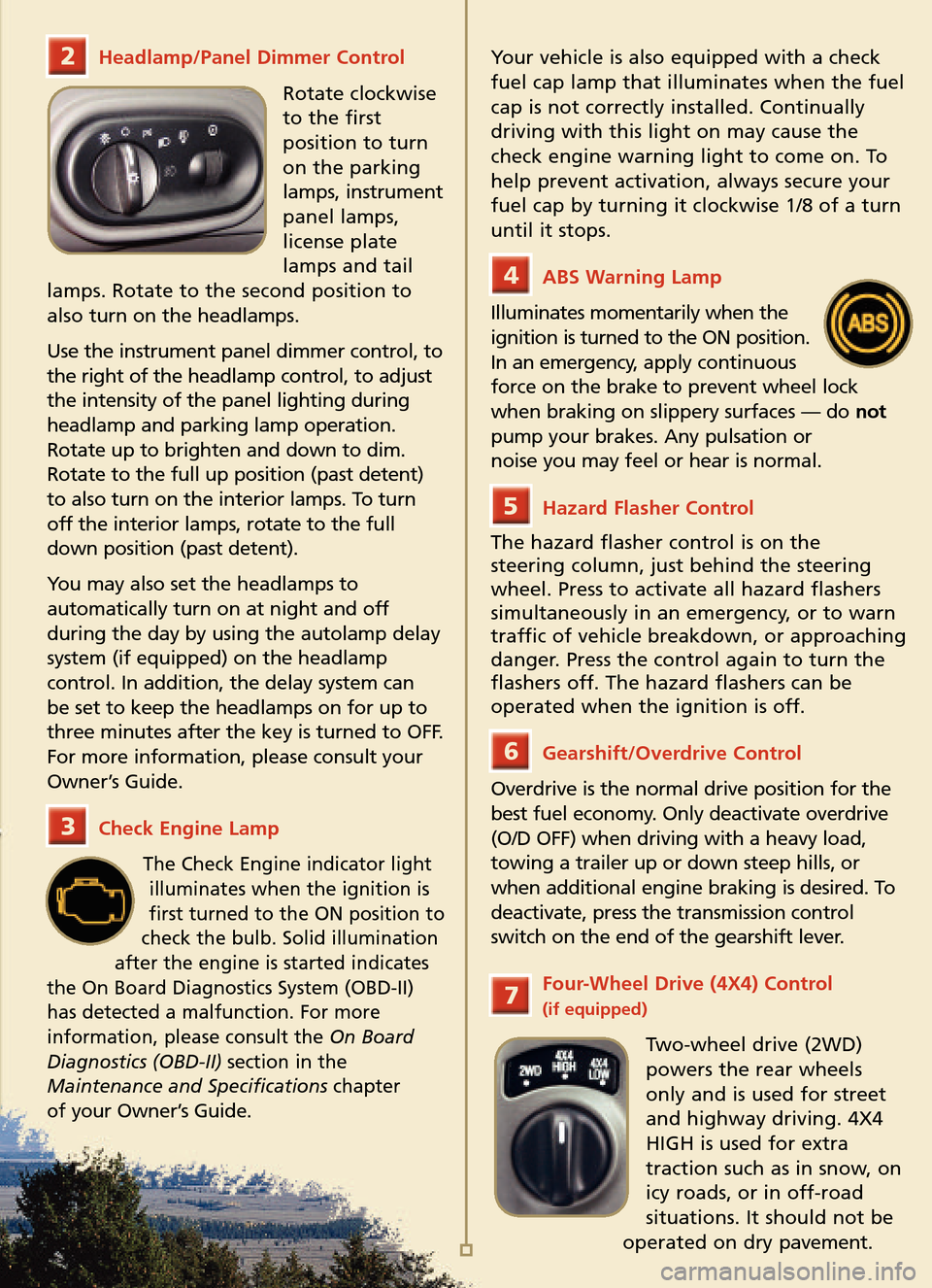tow FORD EXPLORER SPORT TRAC 2005 1.G Quick Reference Guide
[x] Cancel search | Manufacturer: FORD, Model Year: 2005, Model line: EXPLORER SPORT TRAC, Model: FORD EXPLORER SPORT TRAC 2005 1.GPages: 12, PDF Size: 1.15 MB
Page 5 of 12

Tire Pressure– Your tire pressure is properly set at the dealership according to the recommended
specifications found on the Tire Pressure Label on the driver’s door jamb. Please check your tire
pressure during routine maintenance and seasonal changes.
Fuel Tank Capacity– Explorer Sport Trac has a 22.5�gallon tank. Your vehicle is designed to use
“Flex” fuel and “Regular” unleaded gasoline with a pump (R+M)/2 octane rating of 87 for optimum
performance. The use of gasoline with lower octane ratings may degrade performance.
Fuses– If electrical components in the vehicle are not working, a fuse may have blown. For more
information about changing a fuse, please consult your Owner’s Guide.
Fuel Pump Shut�Off Switch– After a collision, if the engine cranks but does not start, the fuel pump
shut�off switch may have to be reset. The switch is located in the passenger’s footwell, by the kick panel.
For more information on resetting your fuel pump shut�off switch, please consult your Owner’s Guide.
Changing the Tires– If you get a flat tire while driving, do not apply the brake heavily. Instead,
gradually decrease your speed. Hold the steering wheel firmly and slowly move to a safe place on the
side of the road. Your vehicle is equipped with a spare tire that can also be used as a regular tire. For
more information on your spare tire, please consult your Owner’s Guide.
Location of the Spare Tire and Tools
Item Location
Spare Tire Under the vehicle just in front of the rear bumper.
Jack, In the passenger�side rear cab compartment
Wheel Nut Wrench behind the access door in the trim panel.
Jack Handle, In the passenger�side rear cab compartment
Jack Handle Extension behind the access door in the trim panel.
Roadside Emergencies– To fully assist you if you should have a vehicle concern, Ford offers a
complimentary roadside assistance program. This program is separate from the New Vehicle Limited
Warranty. The service is available 24 hours a day, seven days a week for the New Vehicle Limited
Warranty period (U.S.) or Basic Warranty period (Canada) of three years or 36,000 miles (60,000 km).Roadside assistance will cover:
Changing a flat tire Jump�starts Limited fuel delivery
Lock�out assistance Towing your vehicle
Roadside Assistance Centers
Country Phone Number
United States (800) 241�3673
Canada (800) 665�2006
For complete details on any roadside assistance concern, please consult the
Roadside Emergencieschapter or the Customer Assistancechapter in your Owner’s Guide.
Page 8 of 12

Headlamp/Panel Dimmer Control
Rotate clockwise
to the first
position to turnon the parking
lamps, instrumentpanel lamps,license platelamps and tail
lamps. Rotate to the second position to
also turn on the headlamps.
Use the instrument panel dimmer control, to
the right of the headlamp control, to adjustthe intensity of the panel lighting duringheadlamp and parking lamp operation.Rotate up to brighten and down to dim.Rotate to the full up position (past detent)
to also turn on the interior lamps. To turn
off the interior lamps, rotate to the fulldown position (past detent).
You may also set the headlamps to
automatically turn on at night and off during the day by using the autolamp delaysystem (if equipped) on the headlamp
control. In addition, the delay system can be set to keep the headlamps on for up to
three minutes after the key is turned to OFF.
For more information, please consult your
Owner’s Guide.
Check Engine Lamp
The Check Engine indicator light
illuminates when the ignition is
first turned to the ON position to
check the bulb. Solid illumination
after the engine is started indicates
the On Board Diagnostics System (OBD�II)
has detected a malfunction. For more
information, please consult the
On Board
Diagnostics (OBD�II)section in theMaintenance and Specificationschapter
ofyour Owner’s Guide.
2
3
Your vehicle is also equipped with a check
fuel cap lamp that illuminates when the fuel
cap is not correctly installed. Continually driving with this light on may cause the
check engine warning light to come on. To
help prevent activation, always secure your
fuel cap by turning it clockwise 1/8 of a turnuntil it stops.
ABS Warning Lamp
Illuminates momentarily when the
ignition is turned to the ON position.
In an emergency, apply continuous
force on the brake to prevent wheel lock
when braking on slippery surfaces — do
notpump your brakes. Any pulsation or
noise you may feel or hear is normal.
Hazard Flasher Control
The hazard flasher control is on the
steering column, just behind the steering
wheel. Press to activate all hazard flashers
simultaneously in an emergency, or to warn
traffic of vehicle breakdown, or approaching
danger. Press the control again to turn the
flashers off. The hazard flashers can be
operated when the ignition is off.
Gearshift/Overdrive Control
Overdrive is the normal drive position for the
best fuel economy. Only deactivate overdrive(O/D OFF) when driving with a heavy load,towing a trailer up or down steep hills, or
when additional engine braking is desired. To
deactivate, press the transmission control
switch on the end of the gearshift lever.
Four�Wheel Drive (4X4) Control (if equipped)
Two�wheel drive (2WD)
powers the rear wheels
only and is used for streetand highway driving. 4X4
HIGH is used for extra
traction such as in snow, on
icy roads, or in off�roadsituations. It should not be
operated on dry pavement.
7
5
6
4